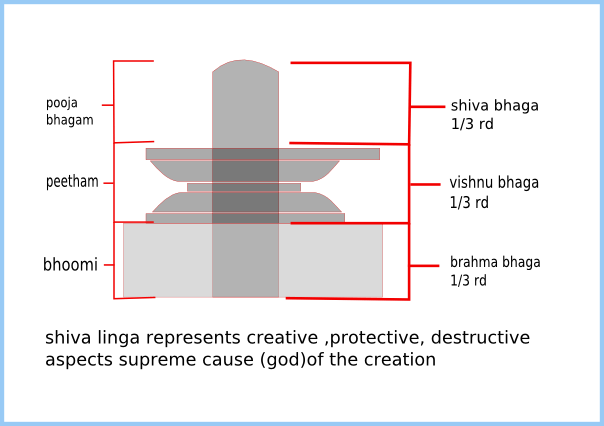Indian iconography
Indian Iconography is the art and science of designing temples: architectural elements, sculpture and the ornamentation of religious significance as described in sacred texts (shilpa shaastra aagamas). In Ancient India twelve years of theoretical and practical training used to be given to the student by an able experienced teacher.
Description, symbolism and Iconometric measurements of various gods' and goddesses' sculpture or images as described in the scriptures is as follows.
Iconography of
God Shiva
Shiva in Lingua form
The sacred texts describe many types of shiva linga based on variations in the proportions. The following is the description of sarvatobhadra shiva lingam preferably constructed in black spotless hard stone which can be worshiped by every living being.
The Shiva linga represents the supreme creator, the cause behind the creation, protection, and destruction of everything visible and invisible and the god shiva.
The sacred texts suggest that the shiva linga must have three parts. A bottom most 1/3rd part that is in the earth - brahma bhaagam (creators part) it is rectangular in cross section. A middle 1/3rd part that is embedded in peetham i.e. visible ornamented pedestal called vishnu bhaagam (protectors part); it is octagonal in cross section. A visible 1/3rd shiva pooja bhaagam which is top most part which is worshiped. It is circular in cross section.
The Shiva linga is at the level of ground and easily accessible to the worshipers irrespective of their caste, social or economic status.

God Vishnu
Hindus are usually Vaishnavites (followers of vishnu). This would indicate the great importance of Vishnu, probably the most popular of Hindu gods. Though in the Hindu Trinity he comes after Brahma, Vishnu remains pre-eminent. he is the Protector-God. Of the three gods of the Hindu Triad, Vishnu, being the Preserver, appears most human. The Rig Vedia Vishnu is conceived as the sun in three stages - rising, zenith and setting. The Vedic Vishnu strides through the heavens in three steps. This is Vishnu`s great deed and constitutes his great glory. With these three steps Vishnu, a solar deity, courses through the three divisions of the universe, "the god being manifest in a threefold form, as Agani on earth, Indra or Vayu in the atmosphere and Surya in the sky". He is said to have taken these three steps for the preservation and benefit of mortals. The zenith is appropriately called Vishnu`s place. His third step cannot be seen with human eyes. It is here that Indra dwells.
Gopura
It is the tower was built on the wall of entrance it was many storied building up to one storied to sixteen storied it's contain kudaivarai, prasthra, karnakuta, sala, panchara, kudu, like many portico is there. It can see mainly in south Indian temples its dravidian architecture.
Gopura
It is the tower was built on the wall of entrance it was many storied building up to one storied to sixteen storied it's contain kudaivarai, prasthra, karnakuta, sala, panchara, kudu, like many portico is there. It can see mainly in south Indian temples its dravidian architecture.
References
- Kaasyapa shilpa shaastra: part-2- department of endowments - andhra pradesh - India.
- Bhaarathiya mahashilpamu: in 16 parts - swarna subramanya kavi - 1971 TTD Govt of Andhra pradesh supported publication.